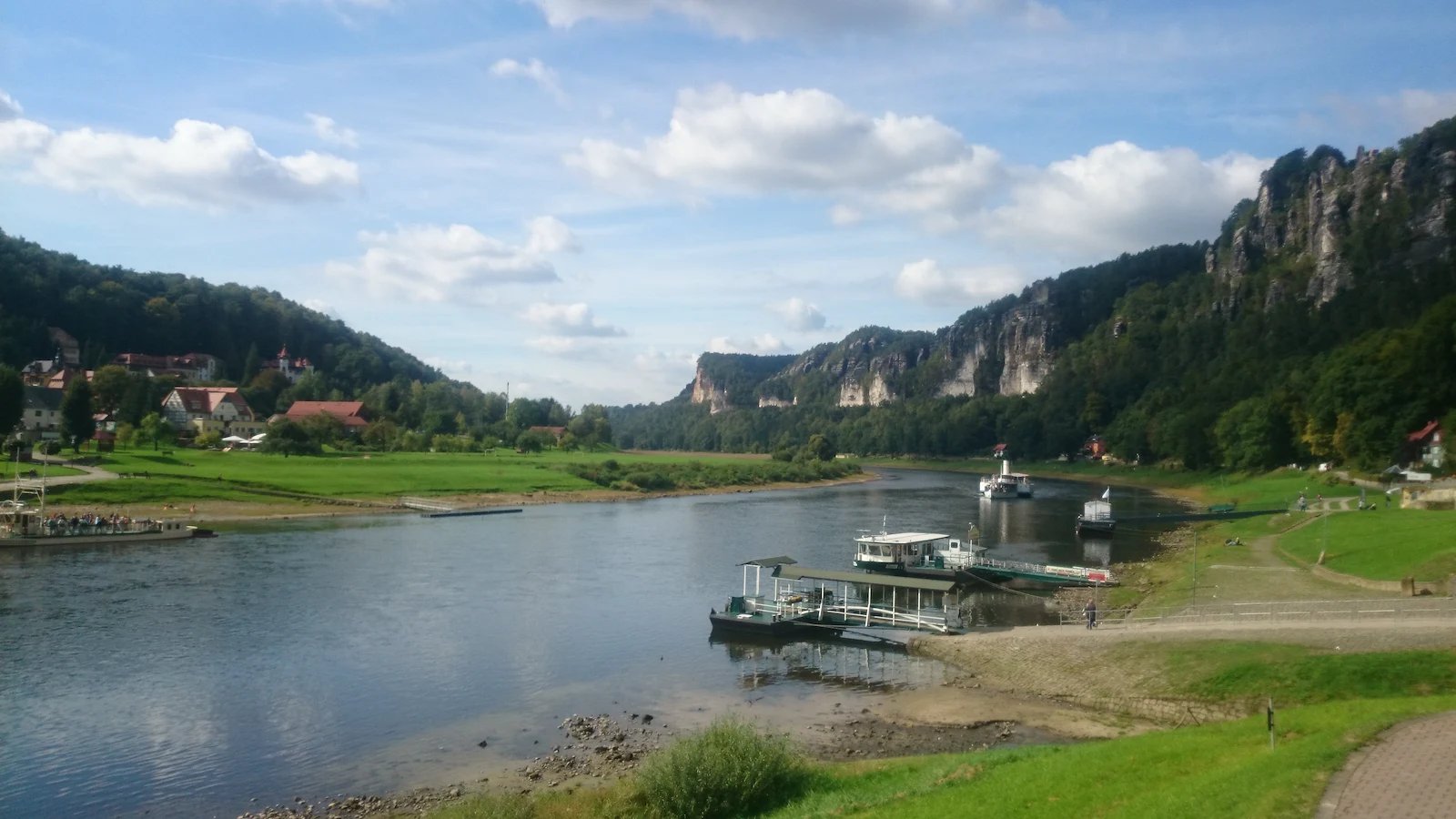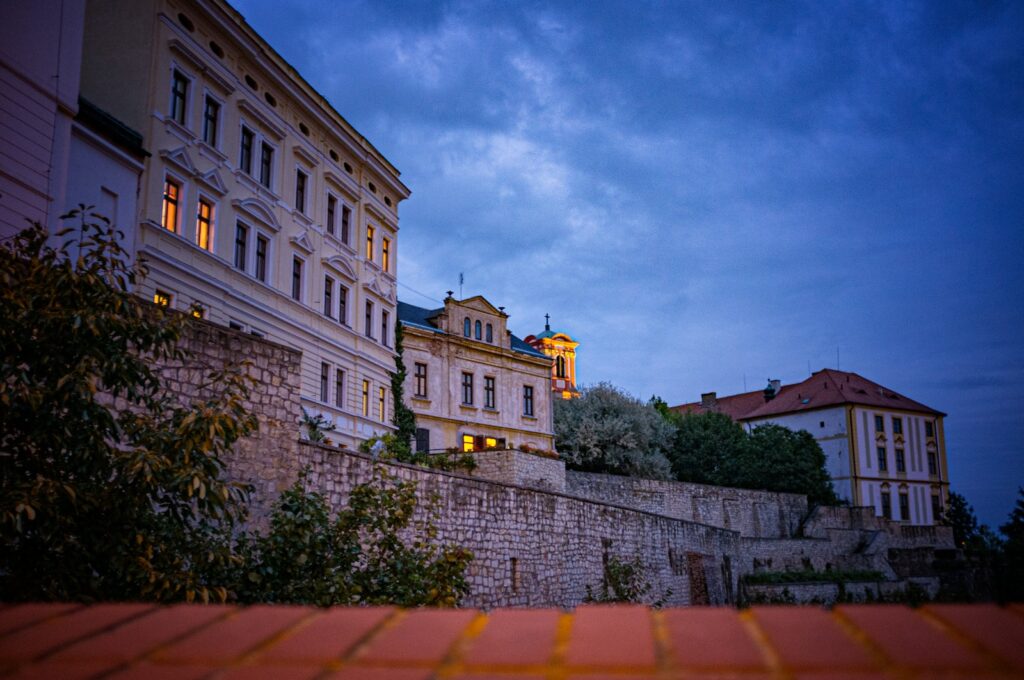Five day tour itinerary
- Day: Prague – Mělník (via Králupy nad Vltavou, Nelahozevěs, Chateau Veltrusy): 60 km
- Day: Mělník-Litoměřice (via Roudnice nad Labem): 50 km
- Day: Litoměřice – Děčín (via Porta Bohemica, Velké Březno and Ústí nad Labem): 55 km
- Day: Děčín – Bad Schandau (Bohemian-Saxon Switzerland): 25 km
- Day: Bad Schandau – Dresden (via Königstein and Pirna): 47 km
Starting in Prague, head north towards Králupy following the Vltava river. After about 4-5 hours of cycling, you’ll reach Mělník, a charming town situated at the confluence of the Vltava and Elbe rivers. There, you can visit the castle, which offers panoramic views of the surrounding landscape and the rivers below. Explore the historic town center with its picturesque streets and cozy bars and cafes.
Mělník is situated on a hill of rock that corrodes and crumbles over time (in Czech “mělní”), which probably gave the city its name. The historic centre is situated on a hill above the confluence of the Vltava (Moldau) and Labe (Elbe) rivers, a unique panorama.
Melnik, along Litoměřice, is an important centre of Czech wine making and particularly famous for its red wines, especially those made from the grape variety known as Melnik (also called Lemberger). This grape is native to the region and produces rich, aromatic wines.
Many local wineries offer tastings, often accompanied by tours of the vineyards and cellars. For example, the winery of Czech aristocrate Jiří Lobkowicz, held in the unique environment of their medieval cellars. You can make reservations through their website.
Day 2: Mělník-Litoměřice (via Roudnice nad Labem): 50 km
Litoměřice is situated near the confluence of the Labe (Elbe) and Ohře (Eger) rivers in the picturesque region of the Bohemian Uplands (České Středohory). It s one of the oldest and most beautiful towns in this part of Bohemia, with St. Stephen’s Cathedral, the Baroque town square and the bishop’s palace being must-sees for any visitor. From the bell tower of the cathedral you can enjoy a wonderful view.
The town has a population of about 25.000 and is a centre of wine making in Bohemia. You can visit the Gothic castle’s wine exhibition for tastings.There are some very good restaurants and wine bars, too, including “Dobrá bašta” and the excellent “Novarank” (google them).
Behind the cathedral is the bishop’s residence – an Italian-style palace complex of buildings. The town is related to one of the most famous and influential Czech poets, Karel Hynek Mácha, who died here.
Detour suggestion: Terezín (Theresienstadt)
Less than 30 minutes cycling from Litoměřice, Terezin originated as a military fortress and garrison town built by the Habsburg Monarchy in the late 18th century. It was constructed in the late 18th century by Emperor Joseph II and named after his mother, Empress Maria Theresa.
The fortress was strategically located near the border between the Czech lands and Germany, serving as a defensive stronghold. It was designed to withstand attacks from Prussia.
During World War II, the Nazis occupied Czechoslovakia and established Terezin as a ghetto and concentration camp for Jews. Terezin served a dual purpose for the Nazis: it was used both as a transit camp for deportations to extermination camps further east and as a propaganda tool to deceive the international community about the true nature of the Holocaust.
Conditions in Terezin were harsh, with overcrowding, inadequate food and sanitation, and rampant disease. Thousands of prisoners died due to these conditions.
Despite the difficult circumstances, Terezin also became a center of cultural and intellectual activity among the Jewish prisoners. They organized clandestine classes, artistic performances, and lectures, demonstrating resilience and defiance in the face of adversity.
In total, around 155,000 Jews were sent to Terezin during the war, and approximately 35,000 perished there, either from the harsh conditions or through deportations to extermination camps such as Auschwitz and Treblinka.
Memorial and Museum:
Today, Terezin serves as a memorial to the victims of the Holocaust. The site includes a museum and various memorials dedicated to preserving the memory of those who suffered and died there. Visitors to Terezin can explore the former ghetto and concentration camp, including barracks, prison facilities, and the Small Fortress (Kleine Festung), which served as the main prison within the complex.
Day 3: Litoměřice – Děčín (via Porta Bohemica, Velké Březno and Ústí nad Labem): 55 km
The third day will take you along the Elbe valley through the Central Bohemian Uplands Again, with the river forming a deep canyon into the hill range. The scenery is quite breathtaking and strongly contrasts the industrial sites of Ústí nad Labem half way to Děčín.
In Děčín, visit Děčín Castle, a stunning hilltop fortress with panoramic views of the Elbe River valley and the surrounding countryside. Explore the historic and enjoy the relaxed atmosphere of this riverside town.
Day 4: Děčín – Bad Schandau: 25 km
Cycle from Děčín across the border into Germany and follow the Elbe to Bad Schandau, less than an hour into from the border. Explore Bad Schandau and enjoy its spa town atmosphere, lovely cafés, restaurants and bike friendly inns. Overnight in Bad Schandau and plan on a hiking tour of half a day im the stunning scemery.
Hiking detour suggestion: Schrammsteine loop
Highlights: Breathtaking views of the Elbe River, iconic sandstone formations, lush forests
Start in Bad Schandau: Begin your hike from Bad Schandau, where you can easily access the trailheads leading into the Saxon Switzerland National Park. Consider stopping by the National Park Center in Bad Schandau for maps, information, and any last-minute supplies you may need for your hike.
Cross the Elbe River using the ferry or the bridge, depending on the route you choose. Once across the river, follow signs leading to the Schrammsteine area.
Ascend to the Schrammsteine: Begin your ascent towards the Schrammsteine rock formations. The trail will lead you through lush forests and rocky terrain as you gradually gain elevation. Enjoy the picturesque scenery along the way, including glimpses of the Elbe below.
Once you reach the Schrammsteine plateau, take some time to explore the unique sandstone formations and enjoy the panoramic views of the surrounding landscape.
You can wander along the well-marked trails that crisscross the area, marveling at the towering rock formations and dramatic cliffs.
Descend to the Elbe River: After exploring the Schrammsteine, begin your descent back towards the Elbe River. Follow the trail as it winds its way through the forest, offering glimpses of the river below.
Return to Bad Schandau: Once you reach the Elbe River, follow the trail back to Bad Schandau, enjoying the tranquil surroundings and beautiful scenery along the way. As you return to Bad Schandau, take some time to relax and reflect on your hike, perhaps stopping for a well-deserved meal or refreshing drink in town.
This hiking tour will give you a wonderful taste of the natural beauty and scenic landscapes of Saxon Switzerland National Park, all within a manageable 4-5 hour timeframe.
Day 5: Bad Schandau – Dresden (via Königstein and Pirna): 47 km
From Bad Schandau, you will pedal on along the Elbe, treated to breathtaking views of the winding waterway flanked by lush forests and towering cliffs. Consider a stop at Königstein Fortress, perched atop a dramatic sandstone mesa overlooking river. Explore the grounds, including its ramparts, courtyards, and museums, and enjoy panoramic views of the surrounding countryside from its lofty vantage point.
Continuing along the riverside path, you’ll reach the charming town of Pirna, known for its well-preserved historic center and colorful Renaissance buildings. Take a leisurely stroll through the cobblestone streets, pausing to admire landmarks such as the Market Square and St. Mary’s Church, and perhaps refuel with a meal at one of the local cafes or restaurants.
Finally, your journey will culminate in the magnificent city of Dresden, renowned for its architectural splendor and cultural heritage. Highlights of your visit may include the iconic Frauenkirche, the majestic Zwinger Palace, and the scenic riverfront promenade known as the Brühl’s Terrace. Take some time to explore Dresden’s museums, galleries, and parks before concluding your bike tour. A good place to feel the vibrant atmosphere of Saxony’s capital city is Dresdner Neustadt, with countless cafés, bars, clubs, and galleries.
Photo credit: Rory Wilmer (www.rorywilmer.com)






















